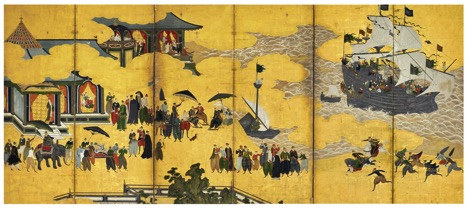HUMAN MIND AND MIGRATION
Immigration, Trade, and Religion: The Changes Caused by Human Movement
Shōtoku Taishi 聖徳太子 (574 – 622) was a semi-legendary Japanese prince who is popular for having brought Buddhism from the continent to Japan. Despite the fascinating story of this prince, the processes that brought Buddhism to Japan were, most probably, more complex, and diverse. Migration and trade seem to have played a major role. Although reaching Japan was objectively difficult during the Nara period (710–784), the commercial relationships between Japan and the continent were lively and relatively spread. The need for commercial exchange triggered the movements of groups of people which, sometimes, turned to be real migration trends, both from Japan to China and vice versa. The danger of navigating the Sea of Japan discouraged the frequent journeys and many Chinese merchants stopped in Japan, sometimes forever. Goods were not the only imported items, but also Buddhist statues and scriptures. Often, monks traveled together with merchants and the more the trade flourished the more religion spread. The scholar Charles Holcombe hypothesizes how trade and immigration could have been the main causes of the “buddhization” of Japan.
Immigration has always caused changes in societies and this is sometimes perceived as the most controversial aspect of immigration. Human beings tend to think of “culture” and “society” as monolithic realities that can be threatened by the arrival of alien influences. However, the huge or small movements of living beings are an endemic characteristic of life, and changes caused by immigration are a natural and unavoidable process and are the basis of the fluidity of cultures.
Bibliography:
Holcombe, Charles. “Trade-Buddhism: Maritime Trade, Immigration, and the Buddhist Landfall in Early Japan” Journal of the American Oriental Society, Apr. – Jun., 1999, Vol. 119, No. 2 (Apr. – Jun., 1999), pp. 280-292
Questions:
To what extent the migration from and toward Japan changed the Japanese religious culture?
Are there similar examples of this phenomenon in other places all over the world?
Historically, how is the Buddhist religious influence perceived by the hosting culture, be it Japan or US in most recent times?
Stay tuned — research findings and original interviews with scholars to follow.
Mariangela Carpinteri
I was born and grew up in the South of Italy (Sicily) and I have spent a few years in Venice to study East-Asian religions at Padua University and at Ca’ Foscari University. I am now a Ph.D. student in Religious Studies at the University of California, Santa Barbara. I am specialized in Japanese religions – Buddhism and Shintō – and I am currently delving into Confucianism. For my Ph D. project, I am studying the relationship between the concept of nature and Japanese religions in the Tokugawa period (1603 – 1868).
